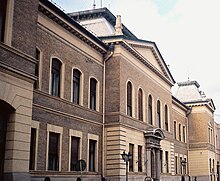Matica srpska
The Matica srpska ( Serbian - Cyrillic Матица српска , German Serbian ancestral mother , from the Old Slavic “matica” for “source”, “origin”) is an important Serbian cultural association .
Matica srpska was founded in Pest (now Budapest) in 1826 based on the model of the one year older Hungarian Academy of Sciences . After being banned and suspended, she moved to Novi Sad in 1864 . The Matica srpska, anchored in the Serbian bourgeoisie, supported students with scholarships and worked to remove the culture and education of the Serbian people from church influence. Vuk Karadžić's reforms , especially his phonetic spelling, were initially rejected by the association. The main goal before the First World War was to strengthen the national consciousness of the Serbs in Hungary .
Role model function
Based on the Serbian model, a Czech Matice česká in Prague (1831), a Croatian Matica ilirska in Zagreb (1842), a Sorbian Maćica Serbska in Bautzen (1847), and a Ukrainian one in Lemberg (1848) were created during the Austrian Empire and later Austria-Hungary ), a Moravian Matice Moravská in Brno (1853), a Dalmatian in Zara (1862), a Slovak Matica slovenská in Martin (1863), a Slovenian in Laibach (1864), a Polish in Lemberg (1880) and a Lower Sorbian in Kottbus (1880).
After the world wars
In the Kingdom of Serbs, Croats and Slovenes , the Matica srpska lost its leading role in cultural life.
After the Second World War , Matica srpska became a scientific and cultural institution that exerted an influence on the entire Serbo-Croatian language area and Yugoslav culture. In 1954, Matica invited srpska to the meeting that led to the so-called Novi Sad Agreement on the Serbo-Croatian language. She also edited various dictionaries and encyclopedias and runs the art museum Galerie Matica Srpska .
Web links
Coordinates: 45 ° 15 ′ 34 ″ N , 19 ° 50 ′ 43 ″ E


